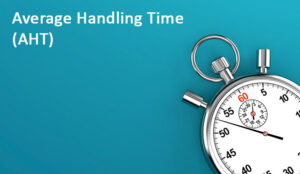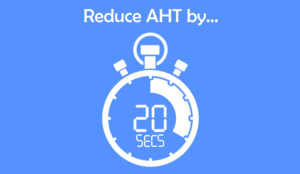CallMiner take us through the basics of average handle time (AHT) and how to safely lower it in the contact centre.
In the simplest terms, AHT is the average time it takes to handle a call or transaction from start to finish – from call initiation, to hold time, to talk time, and all the way through to any related tasks an agent must perform post-phone call to resolve that call.
To calculate AHT, add your total talk time + total hold time + total after-call tasks, and then divide by the total number of calls. That is your average handle time.
Ultimately, AHT is not a success metric. Rushing agents to close tickets rather than resolve issues would hasten your AHT but would not make for happy customers.
However, it is an important metric for calculating call centre levels, assessing efficiency for the call centre overall or for specific agents, and establishing performance benchmarks.
Calculating Your Average Handle Time
Your average handle time is easy to calculate once you’ve gathered some data points. Add your total talk time, your total hold time, and your total after-call tasks. Then, divide by the total number of calls – that figure represents your average handle time.
- Talk Time: This is easy data to obtain: the amount of time your reps spend on a call. Be sure to include any interactive time in which customers are inputting data into an automated system.
- Total Hold Time: Again, this should be another easy-to-obtain number, and it’s even more finite than talk time.
- After-Call Tasks: This is perhaps the most difficult number to evaluate. After-call tasks may vary based on what the call centre handles. For instance, complicated health insurance issues may require some time to handle and then call the customer back, while other customer service issues need no post-call time to handle.
Signs AHT May Be Too Long
Depending on the severity of call centre problems, handling time may not easily show issues in your facility. However, there are a number of factors to look into to see signs of a need to improve your AHT.
Some of these signs include:
- Average Hold Time: Not meaning your total hold time, which is used to calculate your AHT, but your average hold time. It’s common sense that a longer hold time (on average) will increase your AHT.
- Customer Satisfaction: If your customers aren’t complaining, that doesn’t mean they are well satisfied. Using tools to survey and even communicating directly can reveal certain issues that may be roaming through your call centres.
- Repeat Calls: If your customers are having to call more than once in order to handle a single issue, this obviously increases your AHT and (potentially) hurts customer service.
How to Reduce / Improve Average Handle Time
As explained above, there’s an important difference between improving average handle time vs. reducing average handle time: While a call centre could cut corners – e.g. hurry customers off the phone, whether their problems are resolved or not – to reduce AHT, this would lead to dissatisfied customers and other declining metrics, for example first call resolution (due to repeat callers attempting to resolve their issues).
The real benchmark for improved AHT is reduced resolution times PLUS high levels of customer satisfaction.
With this in mind, we define improved AHT as decreasing your average handle time while also increasing your overall customer satisfaction. Additionally, improved AHT may also extend to reducing your call centre costs.
There are several things you can do to improve AHT:
- Optimize Agent Training: Ultimately, average handle time comes down to your agents’ ability to handle common issues. Proper and comprehensive training – CRM, software (including chat and helpdesk) and hardware (including their computers and headsets), business tools, etc., as well as company standards, return policies, etc. – will prepare your agents to handle issues in a timely and effective manner.
- Enable Ongoing Agent Coaching: Efficient agent training is not a do-it-once kind of deal; you must continually nourish and cultivate your team. Agent coaching sessions provide ongoing training to your agents, so they may learn from their experience and work to improve on AHT, without sacrificing service and customer satisfaction.
- Optimize Call Routing: One of the easiest ways to reduce AHT is to route calls to the right representative the first time – no transfers or excessive hold times required. Additionally, proper call routing ensures that your customers are connected with the most knowledgeable agent for their inquiry, which also reduces AHT.
- Build a Comprehensive Knowledge Base: In addition to call routing, building a comprehensive knowledge base is another simple way to reduce AHT. Effective knowledge management, including the use of a knowledge base, makes it easy for agents to immediately access important information, which reduces average handle time.
- Enable Internal Communications: Instead of transferring calls back and forth, or utilizing slow email communications, enable internal agent chat. Answers come faster and as a result, AHT improves.
- Record Calls: Record all calls, both inbound and outbound, and review to identify inefficiencies, problems, and areas for improvement. Use recordings during your agent training sessions.
- Monitor Agent Performance: Again, even the best agents require some level of mentorship and monitoring. Call centre monitoring, as well as conferencing in on calls, are important for ongoing training and also for improving other metrics, like call transfers, hold time, and escalated calls.
- Streamline Processes to Improve Workflow: Reserve your agents for work only agents can do; repetitive tasks, busy work, and similar tasks should be automated, so your team can focus on what they do best.
Examples of Average Handle Time
Sometimes, improving AHT can be as simple as leveraging powerful software to ferret out inefficiencies. For example, one company leveraged CallMiner Eureka to identify the problem behind long silence blocks during billing calls: these happened as agents waited for the billing system to respond to their voice prompts.
After identifying the issue, the problem was handed off to the IT team, who promptly tweaked the system. Literally overnight, AHT fell by 11 seconds.
Benefits of Improved Average Handle Time
The most obvious benefit of improved AHT is customer satisfaction: successfully resolve an issue faster, and customers are happy. But improved AHT also improves contact centre efficiency and reduces costs. By improving AHT, you can:
- Improve the Customer Experience: Timely, successful resolutions make for satisfied customers.
- Improve Operational Performance: As you work through the steps to improve average handling time, you’ll identify various areas for improvement. These will not only boost customer satisfaction, but will also improve contact centre efficiency.
- Reduce Costs: As you improve efficiency, you will also reduce your costs.
Challenges of Average Handle Time
The biggest challenge to improving your AHT is identifying deficiencies. Thanks to technology, however, this stumbling block has grown smaller; powerful interaction analytics software can make quick work of your customer interactions, for example – audio, email, chats, surveys, social media, and texts – to identify common inefficiencies and areas for improvement.
Leverage these insights to optimize contact centre processes and policies, and you’ll be well on your way to improved average handle time.
Best Practices for Average Handle Time
Best practices for average handle time go back to the core definition of AHT: stellar AHT is a function of decreased handle time, increased customer satisfaction, and reduced costs.
This comprehensive approach to AHT defines best practices – the same as listed above for reducing your AHT:
- Optimize agent training
- Enable ongoing agent coaching
- Optimize call routing
- Enable internal communications
- Record and analyze calls
- Monitor agent performance
- Streamline processes to improve workflow
Remember – customer satisfaction is your top priority. As you work toward boosting satisfaction while reducing average handle time, cost reductions will follow.
See how agent coaching in real-time can benefit AHT and multiple metrics in your contact centre.
This blog post has been re-published by kind permission of CallMiner – View the Original Article
For more information about CallMiner - visit the CallMiner Website
Call Centre Helper is not responsible for the content of these guest blog posts. The opinions expressed in this article are those of the author, and do not necessarily reflect those of Call Centre Helper.
Author: CallMiner
Published On: 9th Jun 2020
Read more about - Guest Blogs, CallMiner






 CallMiner is the leading cloud-based customer interaction analytics solution for extracting business intelligence and improving agent performance across all contact channels.
CallMiner is the leading cloud-based customer interaction analytics solution for extracting business intelligence and improving agent performance across all contact channels. 


































